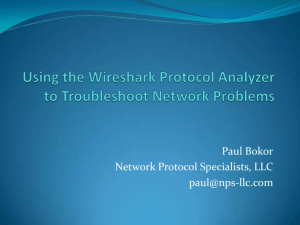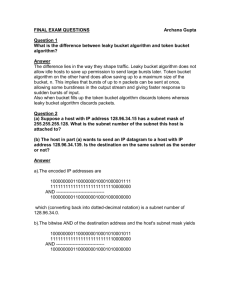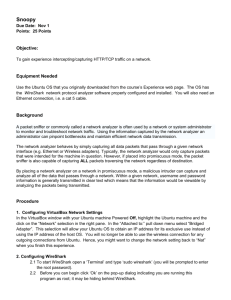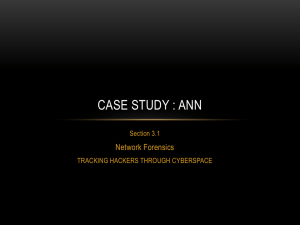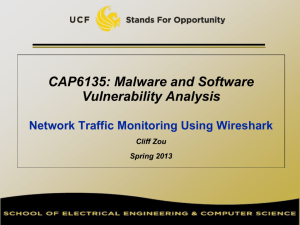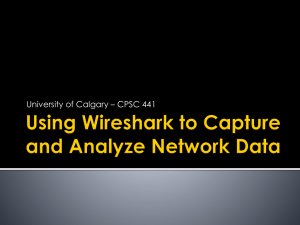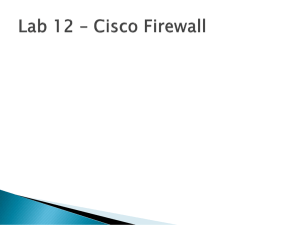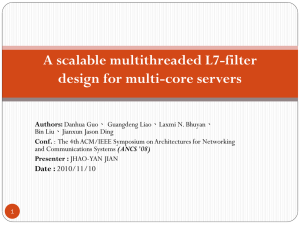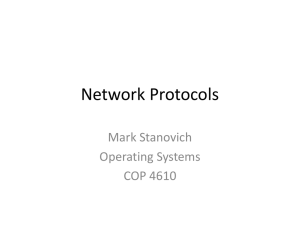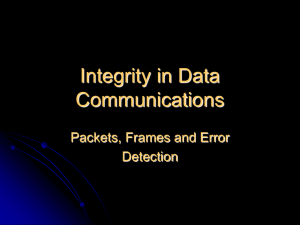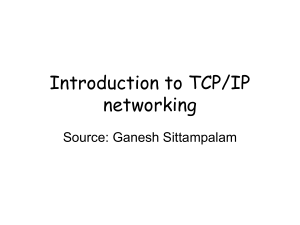PowerPoint used in this workshop
advertisement
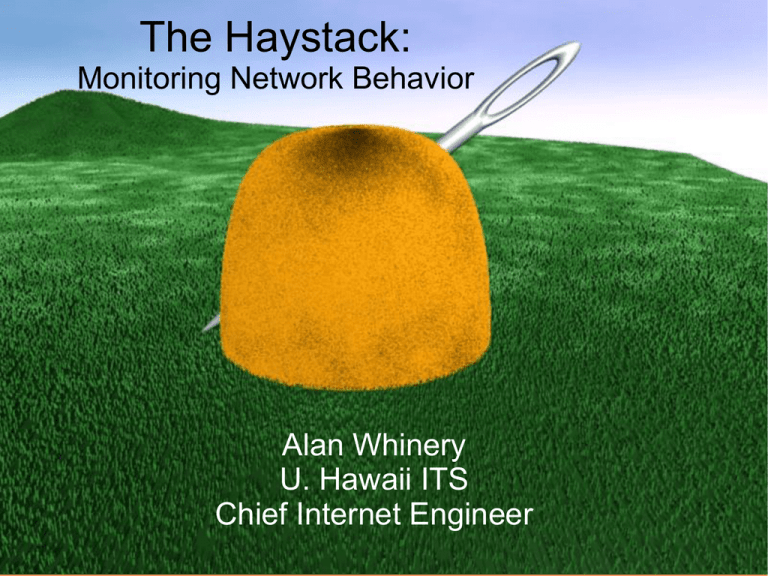
The Haystack:
Monitoring Network Behavior
Alan Whinery
U. Hawaii ITS
Chief Internet Engineer
What this talk is about
Admins: putting concepts in heads, tools in
hands
Users: understanding how to monitor, how you
can be monitored
Does Not Constitute Legal Advice
You are responsible obeying the law, regardless of
what I say today! (et ignorantia juris non excusat)
All readily-available information, I offer no big
secrets
Schiller's Haystack
1993: The best protection is volume of
information. Your best defense is obscurity,
given the size of the “Haystack”
2010: Anything that's not encrypted is no more
private than what's on Facebook.
Your needle needs to be disguised, so it cannot be
found.
And encryption is a can of worms (outside scope)
Packet Sniffing
Any computer that's part of a network can “see”
some packets on its interface to that network
With certain software, you can examine and
save the packets that are “visible” to your
machine's interface
Many are intimidated by the task of packet
sniffing; they spend time with less capable
methods and get less useful results
the broadcast domain
On a switched network, each switch port will
pass only traffic that is addressed to a
destination connected to that port.
If your computer is connected directly to a switch
port, then it will only get packets addressed to it, or
to any group of destinations that includes it
On a multiple access segment (wireless,
Ethernet hub) network, all packets are repeated
to all destinations, and all computers can
observe packets sent by other computers
the broadcast domain
Additionally, a wireless host can listen to
wireless packets, regardless of association.
(this takes special effort, probably need a Unixlike (e.g. BSD, Linux) computer
The Header Train
Ethernet (WiFi, Mobile)
ARP
IPv4
TCP
UDP
SMTP *
IMAP/POP
HTML *
BitTorrent
etc
RTP *
DNS Queries
ICMP
Etc
Common (free) Sniffers
Wireshark (tshark, et al) nee Ethereal
tcpdump
Eldest, CLI-based
ngrep
Common GUI-based, all platforms
Allows capture based on packet contents
Etc.
Programming
libpcap
Scapy
The basis for practically everything. Multi-OS
compatible packet capture library, with interfaces
written for most common languages
Python module; allows VERY versatile packet level
analysis and fabrication
Perl Module Net::Pcap
A simple Perl script can be faster than a complex C
program (like tshark, tcpdump)
Wireshark
Wireshark Frame Decode (SSDP)
Layers within a frame
Wireshark Graph of TCP Transfer
Wireshark Expert Info
Dancing with yourself
It's easy (possibly even legal) to observe your
own traffic, on a single-user computer
This can show you what traffic is reaching your
interface, to examine, network “noise”, attack
signatures, or simply to learn about sniffing
See web cookies, see if your password is “in
the clear”, see why a connection is not working
See what traffic your computer is generating,
Dancing with yourself
Wireshark: menu: Capture->Interfaces
Click “Options” next the interface with the highest
packet count
Dancing with yourself
Wireshark:
Capture options
Capture Filter: “ip”
uncheck
(…) promiscuous
Dancing with yourself
Self-sniffing pitfalls
Using a packet sniffer on a host that is
participating in the traffic being sniffed may:
Fail CRC checks due to CRC off-loading
Have weird packet sizes due to TCP segmentation
off-loading
It's usually cleaner to sniff from a nonparticipant host, using packet mirroring or an
optical splitter
If you want to self-sniff and create capture files
for reference, change interface properties to
exclude any off-loading, to be safe
Mirroring or Splitting
In the 1990's, one machine on the campus
FDDI or multi-access Ethernet backbone could
see all (off-LAN) traffic
Now, in the switched world, all links are point to
point, and there is no way for a third point to be
on a link
Packet mirroring copies packets from a link to a
sniffer port (this is called a SPAN session on
Cisco IOS)
On fiber links, an optical splitter can divert light
to a sniffer, requiring one observing interface
per direction on the sniffer
Promiscuous capture
This places the “sniffing” interface in a special
mode which enables it to receive packets
bound for any destination, whether the local
machine would normally receive them or not
On a switched network, promiscuous is not very
different from non-promiscuous
–
Going non-promiscuous is a way to limit “noise”
On a major link between routers, it allows an
observer to see everything
Legal issues
Significant distinction between “envelope” or
“header” info and “content”
Persons who are employed as network/system
admins may examine “header info” as part of
their jobs
Law enforcement needs court orders to obtain
network info, which may include compelling
provider admins to collect and filter information
Privacy Issues
Always err on the side of caution
Never store traffic captures longer than their
specific purpose calls for
Exposes them to subpoena
“
“
“ compromise
Never share raw captures with outsiders
(except authorized law enf.)
Sanitize and obfuscate
Taking what you need
In doing surveys of OS types in use on our
network in 2008, 2009
Learned that a small, purpose-built Perl script is
MUCH faster than a general case sniffer
Able to match only the piece of packet that had
relevance to the survey and never examine or store
the rest
Most sniffers offer “snap length” parameter,
which allows capturing only the first so-many
bytes of a packet
Saves storage, excludes “content” protects privacy
Storing/Sharing Captures
On a major link which carries about 40% of UH
ingress/egress traffic, capturing 2 million
packets takes about 10 seconds during a
weekday afternoon.
If you limit capture to 60 bytes and estimate
about half of that rate average, that's 518 GB
per day (8.6 billion packets/day)
In order to analyze or characterize that data,
you would need separate machines with access
to the data, and keeping the analysis occuring
at a 1 day per day rate would require constant
optimization.
Storing/Sharing Captures
Sharing data outside the group of people who
have a legal justification to access it is risky,
and you must take steps to eradicate identifying
information, including specific IP addresses
Sanitizing and Obfuscation
Even header information should be “sanitized”
IP addresses may show specific personal behavior
and should be changed, but in a way that doesn't
negate the analysis of traffic
Internet2 observatory deletes the rightmost 11 bits of all
addresses in stored flow data
Several tools exist; if you write a program consider
precedents carefully, there are pitfalls
In stored packet data, the “content” can be
erased, which should not matter unless
checksums are being studied
The “My ex is a net admin” - FAQ
Can my net admins read my email by sniffing?
Probably not, if you always choose the “secure”
encrypted protocols, such as IMAPS, POPS, or web
mail that uses SSL. ITS email set-up instructions
will always specify secure protocols.
Can my ex tap my Internet phone
conversations?
Skype – no. It is AES encrypted, unless you call
China, Dubai, Pakistan, India (???)
Some others, perhaps. But ex would need access
to the right links, and ex would be subject to
criminal prosecution
The “I am a net admin” FAQ
How should I protect myself?
Tirelessly explain your monitoring activities to coworkers and supervisors and invite them to
participate
Don't see anything you shouldn't
Capture as little as possible, take pains to protect
(set permissions, encrypt) any stored capture data
and get rid of it as soon as possible
Remember everything Yoda said about the nature
of the Dark Side
Network Intrusion Detection
Systems
A sniffer allows you to look at packets, a NIDS
looks at them for you
Free ones:
Snort
Probably the broadest community support, medium
difficulty to get going, they're trying to capitalize the
signatures now, to support Snort
AIDE
Bro
Invented by Vern Paxson
(an Orwellian reminder that monitoring comes hand in
hand with the potential for privacy violations)
Snorting (snort.org)
Snort compares packets using “rules”, which are
defined one-by-one to detect specific things,
although some are heuristic
To get to know Snort, you should disable all but
one or two rules and see how that goes, and
then add more rules to suit your needs
Bro (bro-ids.org )
How is Bro different from Snort?
Snort is solely signature based, meaning that it looks for
very specific content in the network stream and reports
each instance of a particular signature. Bro can
analyze network traffic at a much higher-level of
abstraction, and has powerful facilities for storing
information about past activity and incorporating it into
analyses of new activity. Bro also provides a signature
mechanism similar to Snort's.
(excerpted from http://bro-ids.org/FAQ.html )
Intrusion Prevention System (IPS)
Sniffs
Examines traffic
Takes action
Interesting to note – although the Wikipedia article
for NIDS lists examples, the IPS article does
not.
Darknets and Honeypots
A darknet (compare honeynet) is an empty
network with a sniffer on it. The idea is that
scanning attempts and “backscatter” from
various activities will appear on the net as
security references
Contrast with honeypot, which is a decoy machine
set up to detect intrusion attempts, etc.
ICMP Backscatter
tcpdump -ln -i eth1 -w noping-icmp.cap 'icmp[icmptype] != icmp-echo and icmp[icmptype] != icmpechoreply'
Captured with tcpdump, displayed in Wireshark.
Traffic Characterization/Identification
Task of seeing what kind of traffic is on net
Harder than it looks
TCP/UDP port numbers are often meaningless
Many apps are port-agile
BitTorrent uses HTTP-style protocol, sometimes
on port 80
Effective traffic identification involves seeing
every header and understanding protocols
Also interesting to sort by geographic location
(per MaxMind GeoIP )
Byte-Value Distribution Histograms
HTML
00
Stdev % of a-mean
00
00
00
253%
00
00
0
1
4 10 16 22 28 34 40 46 52 58 64 70 76 82 88 94 100 106 112 118 124 130 136 142 148 154 160 166 172 178 184 190 196 202 208 214 220 226 232 238 244 250
7 13 19 25 31 37 43 49 55 61 67 73 79 85 91 97 103 109 115 121 127 133 139 145 151 157 163 169 175 181 187 193 199 205 211 217 223 229 235 241 247 253
MP4 Stream
00
00
00
00
12%
00
00
00
0
1
4 10 16 22 28 34 40 46 52 58 64 70 76 82 88 94 100 106 112 118 124 130 136 142 148 154 160 166 172 178 184 190 196 202 208 214 220 226 232 238 244 250
7 13 19 25 31 37 43 49 55 61 67 73 79 85 91 97 103 109 115 121 127 133 139 145 151 157 163 169 175 181 187 193 199 205 211 217 223 229 235 241 247 253
SSL
00
00
00
00
00
00
00
00
00
00
0
1.3%
1
4 10 16 22 28 34 40 46 52 58 64 70 76 82 88 94 100 106 112 118 124 130 136 142 148 154 160 166 172 178 184 190 196 202 208 214 220 226 232 238 244 250
7 13 19 25 31 37 43 49 55 61 67 73 79 85 91 97 103 109 115 121 127 133 139 145 151 157 163 169 175 181 187 193 199 205 211 217 223 229 235 241 247 253
Byte-Value Distribution Histograms
IPSec ESP
000
000
000
000
000
000
000
000
000
000
0
Stdev
% of a-mean
0.05%
1
4 10 16 22 28 34 40 46 52 58 64 70 76 82 88 94 100 106 112 118 124 130 136 142 148 154 160 166 172 178 184 190 196 202 208 214 220 226 232 238 244 250
7 13 19 25 31 37 43 49 55 61 67 73 79 85 91 97 103 109 115 121 127 133 139 145 151 157 163 169 175 181 187 193 199 205 211 217 223 229 235 241 247 253
WAV Audio
00
00
00
00
57%
00
00
0
1
4 10 16 22 28 34 40 46 52 58 64 70 76 82 88 94 100 106 112 118 124 130 136 142 148 154 160 166 172 178 184 190 196 202 208 214 220 226 232 238 244 250 256
7 13 19 25 31 37 43 49 55 61 67 73 79 85 91 97 103 109 115 121 127 133 139 145 151 157 163 169 175 181 187 193 199 205 211 217 223 229 235 241 247 253
Text emphasizes a small set of characters,
Binary streams (audio/video) involve more widely spread values
Encryption aspires to appear random, and therefore has a flat distribution
Stuff with a text-like distribution is probably text, even if obscured
Stuff with an exceptionally flat distribution is probably encrypted
SNMP
Although more secure(-ish) flavors have been
developed, the vast majority of SNMP is SNMP
versions 1 or 2c.
Access control is generally through a
“community” name which is generally well
known and visible on the wire in SNMP packets
Using community “public” is negligent insanity
If your network printer is using the factory
config, it's a sitting duck
Netflow
Routers and switches send information about
network “flows” to a flow collector.
Flows include source and destination
addresses, port (TCP or UDP) numbers, router
interface, and volume of traffic
Flows usually reflect less than 100% of traffic
through a router.
Free tools for dealing with netflow data are
available (e.g. flow-tools); not as cool as sniffer
tools
Simple Network Management Protocol
(SNMP)
Routers, switches provide extensive information about
what they're doing
Interface packet/byte counts, up-time, temperatures,
route tables, forwarding caches, etc.
Servers, printers, wireless APs, SOHO gateways
SNMP provides variables for a mgmt station to query,
or traps, which are messages initiated by the router,
switch, printer, etc, in question.
Topology Discovery
In a network where you know the SNMP
community names, it is reasonably simple to
use bridge and route tables to discover network
topology. This provides a list of network devices
(routers, switches), and interfaces.
Non-Passive Monitoring
NMAP
Scans for listening TCP/UDP services on a host
Other scanners apply tests for vulnerabilities
SAINT
MetaSploit
Nessus (source moved from open to closed)
OpenVAS (fork of Nessus's open source)
Network quality checking: web100
The Web100 add-ons for Linux allow an
observer to collect stats on TCP connections, to
determine whether the network is performing
well
Info available includes indicators of congestion,
TCP host tuning, and throughput
Examples apps that use web100: NDT, NPAD
Host accounting
It is necessary to account for the computers on
a network for many reasons
Host infections
Unacceptable behaviors
Identifying stolen devices
This can be done by gathering ARP/ND tables
using SNMP, or by parsing switch logs or DHCP
server logs.
Host OS Survey (Perl fragment)
if ($pkt =~ /(User-Agent: .*)/i)
{
$matchcounter++;
my $ua = $1;
$ua =~ s/^user-agent: //i;
print "$ipsrcadd^$ua\n";
}
“User-Agent: is placed in an HTTP request
header by a browser, and most identify the
operating system in use, but not a specific host.
This example never captures anything but UA.
Service accounting
ngrep -d eth1 -O ngrep-server-hdrs2.cap -q
"HTTP/.*Server: .*Content-Type: text/" \(src net
128.171 or src net 132.160 or src net 166.122
or src net 168.105\)
Find HTTP servers on our nets, regardless of port
tcpdump -i eth0 -ln 'tcp[13] & 18 = 18' and src
port 25
Find services answering TCP port 25 (commonly
SMTP)
